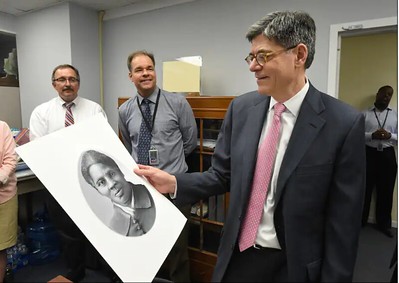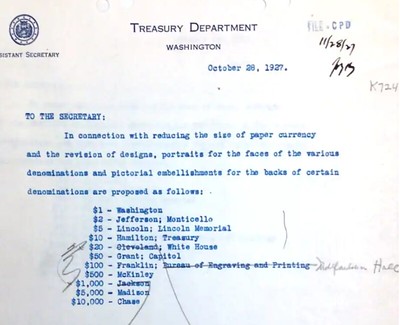
PREV ARTICLE
NEXT ARTICLE
FULL ISSUE
PREV FULL ISSUE
WHEN WILL HARRIET TUBMAN ADORN THE $20 BILL?Kellen Hoard passed along this Washington Post article about planning for a Harriet Tubman portrait on the U.S. $20 bill. -Editor Kellen notes that the article... "[included a] memo from Treasury Staff to Treasury Secretary Andrew Mellon suggesting people to be featured on the new currency designs. Interestingly, Mellon in pencil reversed the positions of Cleveland and Jackson."
President Biden's White House basked in praise from allies in its early days when it pledged to look for ways to But four months after taking office, there is little evidence that the administration has taken any steps to accelerate the schedule set out years ago by a small agency within the Treasury Department. Despite the growing national push to honor the contributions of women and people of color — and Biden's personal promise to do so — Tubman is still not set to appear on the $20 by the end of Biden's first term, or even a hypothetical second term. If the current timeline holds, it will have taken a full 16 years to realize the suggestion of a 9-year-old girl whose 2014 letter to then-President Barack Obama publicly launched the process.
Biden has made other efforts to update the nation's imagery. He recently became the first president to visit Tulsa in commemoration of a race massacre there. He ordered that the Oval Office be cleared of a portrait of Jackson, who oversaw the Indian Removal Act that led to the But removing the portrait has proven much easier than accelerating the actions of the Bureau of Engraving and Printing, a unit of the Treasury Department, which critics say displays scant interest in transforming the currency. Treasury officials say changing the portrait on the $20 is not as simple as it sounds, largely because of the need for sophisticated anti-counterfeiting features.
Olijar said the schedule for new currency is recommended by a group called the Advanced Counterfeit Deterrence committee, which advises the treasury secretary on anti-counterfeiting issues. Under that schedule, both the $10 and the $50 notes are set to be released ahead of the $20.
Changing America's money has long been a glacial process. One Treasury aide said the blue thread that appears in the recently released $100 bill took the government a decade to develop. Complicating matters further, the effort to change the Jackson portrait is caught up in a 2008 court order that any new currency must include some kind of tactile signifier, similar to Braille, so those who are blind or visually impaired can distinguish between various denominations. Like supporters of the Tubman portrait, representatives of the blind are still waiting.
Her research shows how much easier it was to put Jackson on the currency than it's proving to get him off it. When the modern currency was first designed nearly a century ago, then-Treasury Secretary Andrew Mellon received a typed memo from his staff suggesting individuals to be honored on the new bills, a copy of which was unearthed in the National Archives by Robbins and her colleague Genevieve Tung. The October 1927 memo listed former president Grover Cleveland as the proposed face of the $20 and Jackson for the $1,000. Mellon crossed their names out and, with his pencil, ordered their positions reversed.
To read the complete article, see:
THE BOOK BAZARREWayne Homren, Editor The Numismatic Bibliomania Society is a non-profit organization promoting numismatic literature. See our web site at coinbooks.org. To submit items for publication in The E-Sylum, write to the Editor at this address: whomren@gmail.com To subscribe go to: https://my.binhost.com/lists/listinfo/esylum All Rights Reserved. NBS Home Page Contact the NBS webmaster 
|

